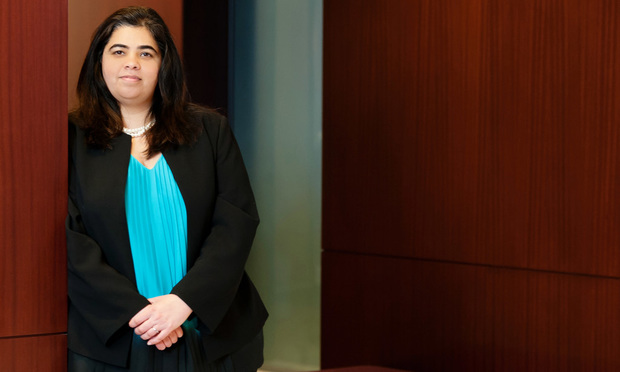What You Need to Know About Traveling to the US During Summer Holidays
Millions of international citizens travel to the United States each year for tourism, an industry that generates revenues of about $100 billion for the U.S. economy each year. Therefore, the United States has a vested interest in ensuring that the country remains accessible to tourists.
June 14, 2019 at 12:19 PM
6 minute read
 Karuna Simbeck of Klasko Immigration Law Partners.
Karuna Simbeck of Klasko Immigration Law Partners.
Millions of international citizens travel to the United States each year for tourism, an industry that generates revenues of about $100 billion for the U.S. economy each year. Therefore, the United States has a vested interest in ensuring that the country remains accessible to tourists. Under the visa waiver program (VWP), the United States permits citizens of 30 countries visa-free travel to the United States for business or tourism for stays of up to 90 days. In return, those 30 countries permit U.S. citizens and nationals to travel to their countries for a similar length of time without a visa for business or tourism purposes. Additionally, Canadian citizens generally do not need a visa to enter the United States as tourists. Those who don't qualify under VWP can apply for B-1 visa (visitor for business); a B-2 visa (visitor for pleasure) or a combination B-1/B-2 visitor visa.
As we head into summer travel, this article will focus on the two most frequently asked questions about traveling to the United States on a B-2 visa.
To qualify for a B-2 visa, the applicant must not be ineligible due to previous immigration or criminal violations. Additionally, they must prove to the consular officer that they have sufficient ties to their home country in order to show that any visit to the United States would be brief and temporary. At each entry into the United States on a B-2 visa, a foreign national can be authorized to stay for up to 180 days in the United States.
Length and Frequency of Travel
The most common question immigration attorneys receive about traveling to the United States on a B-2 visa is: “How often can I come to the United States?”
Each time a person comes to the country as a visitor, the officer must be able to determine that the person is simply visiting; and that the purpose, duration and frequency of trips to the United States is consistent with evidence that the person permanently lives abroad.
There is no bright line rule for how many times a tourist can use their B-2 visa to enter the country. Instead, Customs and Border Patrol (CBP) will look at the tourist's travel history to determine if they are coming to the United States for brief, temporary stays, or using the tourist visa to essentially live or work in the United States. Visitors who frequently spend prolonged periods of time in the United States may have difficulty convincing the CBP officer that they do not have intent to live or work in the United States.
For example, a person who enters the country once a year and stays for a couple of weeks or months at a time, is not likely to be stopped and questioned about their intent at the border. However, if a person were to enter the United States for a few months, depart for a few days or weeks and re-enter for a few months, they are more likely to be stopped at the border and questioned about the purpose of their visits to the United States. If the CBP officer does not believe that the person is coming in for brief and temporary stays, the officer can limit how much time the tourist is allowed to stay in the United States and in some rare cases, can prevent the tourist from entering the United States entirely.
So, depending on the frequency and duration of their trips, two trips in a year may be too many, or five trips in a year may be fine.
Ultimately, the CBP officer is assessing each visitor's honesty and reliability when interviewing the foreign national. The officer will also be considering any evidence they have brought with them of the purpose of their trip, duration of the trip and the immigration service's own records of the person's travel history.
If the officer is concerned about previous travel history or the foreign national's intent, the officer can reduce the period of authorized stay from six months to a handful of days. In the most serious of cases, the officer can refuse a foreign visitor entry into the United States.
Permissible Activities on a B-2 Visa
While the frequency and duration of visits are the most common questions, we also receive many questions about what activities are permissible on a B-2 visa.
Given the temporary nature of the visa purpose, it can only be used for certain activities within the United States, such as tourism, visiting family and friends, medical treatment, short recreational courses of study or other similar activities. Courses may not be for credit toward a degree, but rather for example, a one-day cooking class while on vacation.
Certain activities are not permitted on visitor visas, including study and work. What constitutes “work” can be a tricky question. There is a common misconception that if an activity is unpaid, it is not work. Unfortunately, this is not true. For instance, working for free at a family friend's business while on a tourist visa would be construed as work. Babysitting a family member's children for room and board could also be considered employment.
B-2 visitors should be forthright about the reasons why they are seeking a B-2 visa at the U.S. Consulate overseas. After being granted the B-2 visa, it is important the foreign national be aware of restrictions on the B-2 visa and to ensure that all activities in the U.S. are consistent with the B-2 status. If there's ever any doubt whether a certain activity is permitted on a B-2 visa or if multiple or prolonged trips to the United States might trigger issues at the border, the B-2 visitor should schedule a consultation with an immigration attorney.
Karuna Simbeck is an associate in Klasko Immigration Law Partner's Philadelphia office and a member of the firm's EB-5 practice. As part of the EB-5 team, she is involved in various stages of the EB-5 process, including the preparation and filing of I-526 petitions for both regional center investors and individual investment opportunities.
This content has been archived. It is available through our partners, LexisNexis® and Bloomberg Law.
To view this content, please continue to their sites.
Not a Lexis Subscriber?
Subscribe Now
Not a Bloomberg Law Subscriber?
Subscribe Now
NOT FOR REPRINT
© 2025 ALM Global, LLC, All Rights Reserved. Request academic re-use from www.copyright.com. All other uses, submit a request to [email protected]. For more information visit Asset & Logo Licensing.
You Might Like
View All

Energy Lawyers Field Client Questions as Trump Issues Executive Orders on Industry Funding, Oversight
6 minute read
Trending Stories
- 1Some Thoughts on What It Takes to Connect With Millennial Jurors
- 2Artificial Wisdom or Automated Folly? Practical Considerations for Arbitration Practitioners to Address the AI Conundrum
- 3The New Global M&A Kings All Have Something in Common
- 4Big Law Aims to Make DEI Less Divisive in Trump's Second Term
- 5Public Notices/Calendars
Who Got The Work
J. Brugh Lower of Gibbons has entered an appearance for industrial equipment supplier Devco Corporation in a pending trademark infringement lawsuit. The suit, accusing the defendant of selling knock-off Graco products, was filed Dec. 18 in New Jersey District Court by Rivkin Radler on behalf of Graco Inc. and Graco Minnesota. The case, assigned to U.S. District Judge Zahid N. Quraishi, is 3:24-cv-11294, Graco Inc. et al v. Devco Corporation.
Who Got The Work
Rebecca Maller-Stein and Kent A. Yalowitz of Arnold & Porter Kaye Scholer have entered their appearances for Hanaco Venture Capital and its executives, Lior Prosor and David Frankel, in a pending securities lawsuit. The action, filed on Dec. 24 in New York Southern District Court by Zell, Aron & Co. on behalf of Goldeneye Advisors, accuses the defendants of negligently and fraudulently managing the plaintiff's $1 million investment. The case, assigned to U.S. District Judge Vernon S. Broderick, is 1:24-cv-09918, Goldeneye Advisors, LLC v. Hanaco Venture Capital, Ltd. et al.
Who Got The Work
Attorneys from A&O Shearman has stepped in as defense counsel for Toronto-Dominion Bank and other defendants in a pending securities class action. The suit, filed Dec. 11 in New York Southern District Court by Bleichmar Fonti & Auld, accuses the defendants of concealing the bank's 'pervasive' deficiencies in regards to its compliance with the Bank Secrecy Act and the quality of its anti-money laundering controls. The case, assigned to U.S. District Judge Arun Subramanian, is 1:24-cv-09445, Gonzalez v. The Toronto-Dominion Bank et al.
Who Got The Work
Crown Castle International, a Pennsylvania company providing shared communications infrastructure, has turned to Luke D. Wolf of Gordon Rees Scully Mansukhani to fend off a pending breach-of-contract lawsuit. The court action, filed Nov. 25 in Michigan Eastern District Court by Hooper Hathaway PC on behalf of The Town Residences LLC, accuses Crown Castle of failing to transfer approximately $30,000 in utility payments from T-Mobile in breach of a roof-top lease and assignment agreement. The case, assigned to U.S. District Judge Susan K. Declercq, is 2:24-cv-13131, The Town Residences LLC v. T-Mobile US, Inc. et al.
Who Got The Work
Wilfred P. Coronato and Daniel M. Schwartz of McCarter & English have stepped in as defense counsel to Electrolux Home Products Inc. in a pending product liability lawsuit. The court action, filed Nov. 26 in New York Eastern District Court by Poulos Lopiccolo PC and Nagel Rice LLP on behalf of David Stern, alleges that the defendant's refrigerators’ drawers and shelving repeatedly break and fall apart within months after purchase. The case, assigned to U.S. District Judge Joan M. Azrack, is 2:24-cv-08204, Stern v. Electrolux Home Products, Inc.
Featured Firms
Law Offices of Gary Martin Hays & Associates, P.C.
(470) 294-1674
Law Offices of Mark E. Salomone
(857) 444-6468
Smith & Hassler
(713) 739-1250






